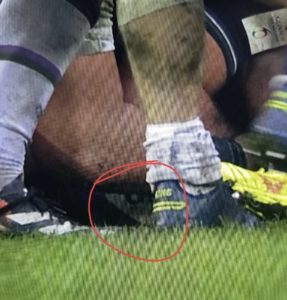Match officials have been let down by World Rugby’s TMO protocol, writes SIMON BORCHARDT.
“What the game needs to do at the moment is decide what it wants to be. Does it want to be perfect and get every single decision right? That means a more stop-start game with less flow and less fatigue. Or do you want a game which is imperfect? Well, if so then don’t come out and criticise match officials who leave decisions on the pitch.”
So said recently-retired Test referee Wayne Barnes in an interview with Rugby World that was republished by SA Rugby magazine three months ago.
I thought of that while waiting almost five minutes for the on-field officials and TMO to decide whether Sam Skinner had scored a match-winning try for Scotland against France in the Six Nations clash at Murrayfield.
Referee Nic Berry did not see the ball being grounded by Skinner, so he indicated “held up” before bringing in TMO Brian MacNeice. Following World Rugby TMO protocol, Berry told MacNeice that his on-field decision was “no try” which meant the TMO required conclusive evidence that a try had been scored to overturn the decision.
TV replays showed the ball had initially been placed on a French boot, before sliding off it and appearing to be grounded (the bottom of the ball was obscured). MacNeice confirmed this to Berry, who asked if he should change his decision to a try. The TMO replied saying he needed to find clear evidence that the ball was on the ground and when he couldn’t, the referee had no choice but to stick with his on-field decision.
Those final minutes in France’s #GuinnessSixNations win over Scotland 👀
What did you make of the TMO decision? pic.twitter.com/bPR3yo0T3Y
— SuperSport Rugby (@SSRugby) February 11, 2024
Predictably, the match officials were booed by the Murrayfield crowd and slammed on social media by those who believed Scotland had been robbed. Their ire was misdirected, though. The officials had done their jobs by following protocol, so if the wrong decision was made, then it’s the protocol to blame, not them. Had Berry simply asked the TMO “try or no try?” – as referees used to do – and not made an on-field decision first, Scotland would almost certainly have won the game, because while the bottom of the ball was hidden, based on its position it must have been grounded.

The role of the TMO in rugby has been hotly debated in recent years. Some believe it’s a vital tool to ensure correct decisions are made in a professional sport where players and coaches’ livelihoods are on the line. Others think the TMO should only be used to determine if a try has been scored (and not for other incidents like a forward pass or foul play), while there are those who want the TMO to be scrapped entirely, with on-field officials making all calls based on what they see with their own eyes.
I don’t think the TMO is going anywhere, but I do think World Rugby’s TMO protocol needs to be refined to prevent a repeat of the Murrayfield fiasco.
Why can’t a referee go to the TMO with a simple “try or no try?” and then make the decision himself after watching the replays on the big screen and getting some feedback from the TMO?
World Rugby must also do more to reduce the time it takes for officials to make a TMO-referred decision. How often has the same angle been replayed five, six or seven times, in super slow motion, only for the officials to remain undecided and ask for another angle? Officials should only be allowed to watch a specific angle of an incident twice – and then either make a decision or move on to another angle. That would speed up the whole process.
To answer Barnes’ question, a complicated contact sport like rugby will always be an imperfect game in which mistakes will be made, but it can become a better game to play and watch by refining the use of technology and providing officials with protocol that helps rather than hinders them.
Photo: Stu Forster/Getty Images





